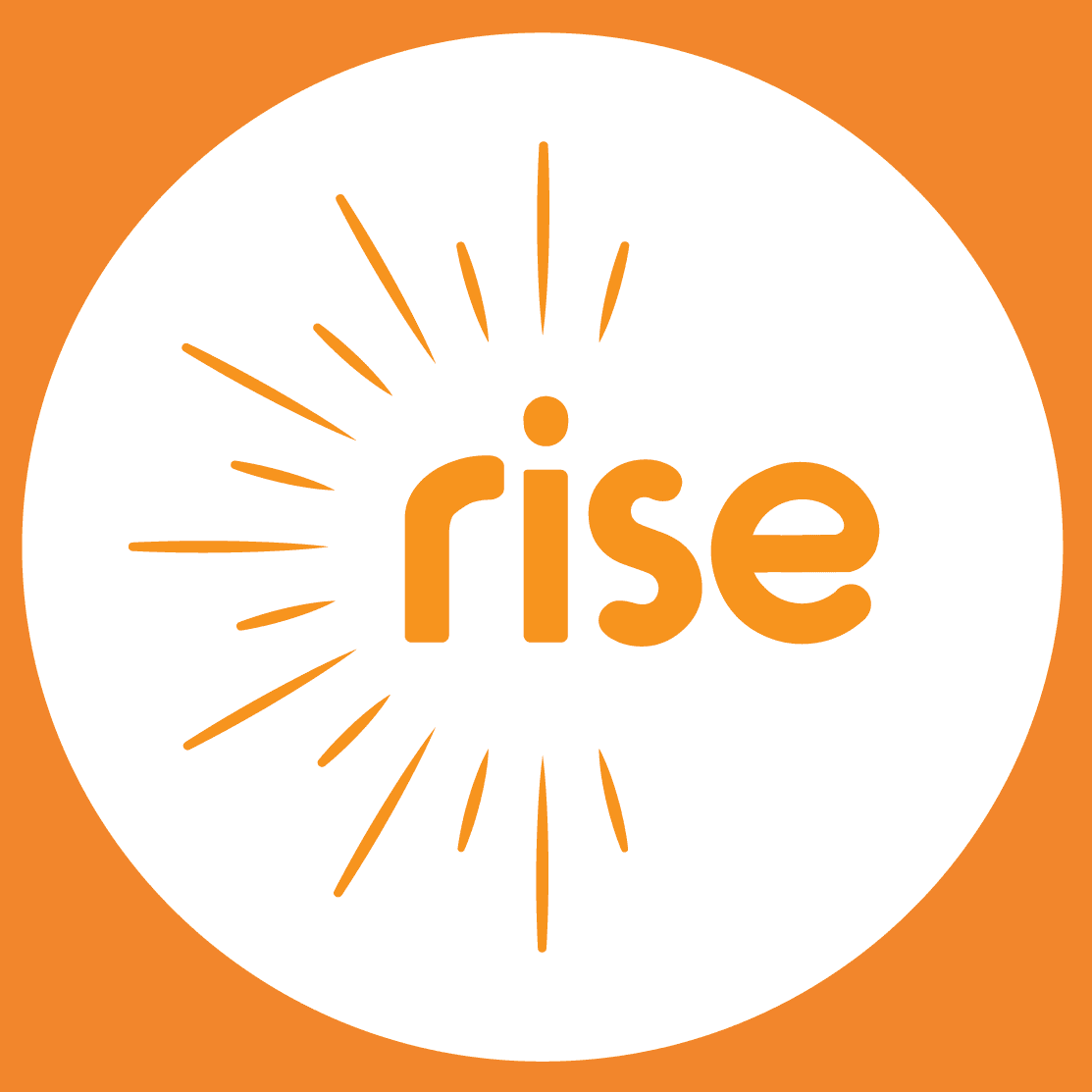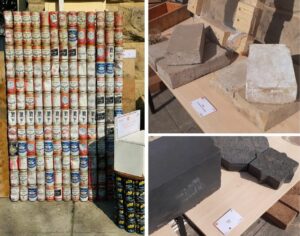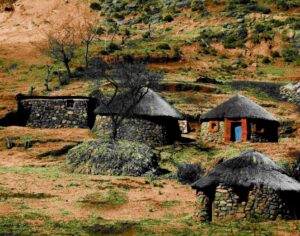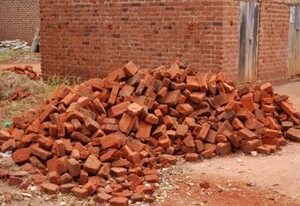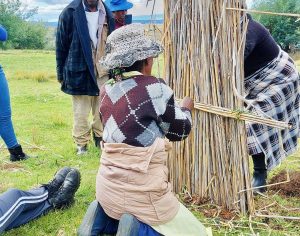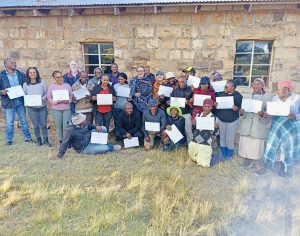Building with Sheep Wool
Desk Research & Primary Findings
Issued on: 30th August 2023
1. Background
1.1. Overview of Wool
Baumgartner (2021) explains that Lesotho has a rich history and tradition in its wool industry, with high-quality wool produced by the nation’s sheep since the 1800s. The industry has a well-established network that connects local producers with brokers in South Africa who purchase the raw product for processing and sale. According to Forrester (2021), wool is the backbone of Lesotho’s rural economy, with producers ranging from smallholder farmers to breeders of large flocks with superior genes. Currently, there are over 1.2 million sheep with a significant potential for industry development. On average, one sheep produces nearly three kilograms of wool annually. Primarily, Lesotho exports raw wool to warehouses in Port Elizabeth, South Africa for grading and processing for readiness for the international market. 80% of the wool is the exported to China, while the remaining 20% is exported to European countries labeled as South African wool, along with South African wool (The Reporter Newspaper, September 22, 2022).
The observation was that wool is currently not utilised for insulation in buildings in Lesotho. According to the International Wool and Textile Organisation (2020), wool has diverse uses, which depend on the coarseness of the fiber and its other characteristics, including fiber length and crimp. Besides widespread use in the textile industry, there is an opportunity to use the insulation properties of wool in buildings which necessitated this research into the viability of the use of wool, in particular the lower grades of wool that are less attractive for the textile industry, and can be used as an insulation material in construction industry instead (The International Wool and Textile Organisation, 2020).
1.2. Wool as a building material
According to Renz (2022), wool has become increasingly significant in the construction industry due to its many natural properties. According to SANS 10400, XA building towards more sustainable and less resource-intensive building practices will reduce energy consumption. The goal is for all new residential and commercial buildings to contribute an estimated 3,500 MW of electricity savings. As nature has often inspired technological innovation and intelligent design, sheep wool is now at the forefront of these advancements (Renz, 2022). Renz (2022) further adds that the rising popularity of wool as an insulation material in construction is due to increased awareness regarding the health benefits and performance of natural fiber insulation. The thermal insulation is typically measured by its thermal resistance often referred to as the R-value which determines the type of insulation that is required. According to SANS 10400 XA, Lesotho’s climate requires a minimum R-value of 3.7 for insulation purposes. This would support the cause for effective insulators such as sheep wool. The table in Annex 1 Material Specification relays a comparison of wool’s thermal performance against other conventional materials.
This research explores the possibility of using wool as a brick and an insulating material in Lesotho, looking at its availability, durability, cost, and thermal efficiency
1.3. Wool bricks
Fecyt (2010) reports that researchers from Spain and Scotland conducted a study on the use of sheep wool in various composite materials, such as adobe bricks and cement mortar, and made several significant findings. The research revealed that wool fibers can enhance the strength of compressed earth bricks, decrease the occurrence of fissures and deformities due to contraction, reduce the bricks’ drying time, and increase their resistance to flexion (refer to Figure 1). Remarkably, these wool bricks can be produced without firing, resulting in energy conservation. Also, bricks are considered a sustainable and healthy alternative to conventional building materials, which is why wool bricks are gaining more attention in research (Fecyt, 2010).
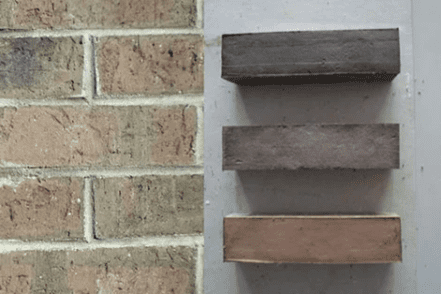
2. The advantages of Wool
Wool is a sustainable and renewable material that is also natural. It does not cause any harm to human health and is non-irritating to the eyes, skin, or lungs. Unlike rock wool or fiberglass wool, which is hazardous to install, wool fibers are much safer to handle. Wool is breathable and can absorb and release moisture without compromising its thermal performance, making it ideal for insulation (Denes, Manea & Florea, 2019). Additionally, wool is fire-resistant and can extinguish itself in the event of a fire. It can also absorb volatile organic compounds (VOCs) from the environment, making it an excellent choice for indoor air quality. Wool is static-resistant and does not attract lint and dust, making it resistant to dirt. It is an effective insulation material for both thermal and acoustic purposes, as it absorbs noise and reduces noise levels. When wool fibers absorb moisture, they generate heat, which helps to prevent condensation in structures and minimize the risk of mold and mildew formation (Denes, Manea, & Florea, 2019).
A sustainable and renewable material, sheep’s wool insulation has no adverse impact on the environment. It boasts an R-value of approximately 3.5 to 3.8 per inch of material thickness, which is 0.3 to 0.6 points higher than fiberglass, cellulose, or mineral wool. A higher R-value indicates that a material is more effective at resisting the flow of heat (Denes, Manea & Florea, 2019).
Sheep’s wool insulation is a versatile and eco-friendly option available in various sizes and thicknesses, including slabs, batts, and rolls. It is a completely natural product that requires 15% less energy to manufacture compared to glass wool insulation, making it more sustainable. Thanks to its high nitrogen content, sheep’s wool is one of the few fibers that are naturally flame-resistant and self-extinguishing. Instead of igniting, it will simply smolder and singe away, reducing the risk of fire (Denes, Manea & Florea, 2019).
3. Disadvantages of Wool
The installation of sheep’s wool insulation can be costly. For example, in Europe, it can cost approximately €62 (equivalent to M1240) per square meter to achieve the recommended thickness of 300mm. This is considerably more expensive than mineral insulation, which costs around €17 (M340) per square meter (Tiza, Singhs, Kumar & Shetta, 2021). Another disadvantage of wool insulation is related to its cleaning and preparation process. To make it effective and suitable for use, wool must undergo treatment and cleaning that involves the use of harsh chemicals for disinfection and to address possible scab mite infestations (Tiza, Singhs, Kumar & Shetta, 2021).
4. Primary Explorative Research Findings
To collect primary data, snowballing was a suitable sampling technique for this study, because it was imperative to select participants with first-hand knowledge about wool from a wide range of participants. This chapter presents the findings from the face-to-face interviews that lasted between 45 minutes to an hour each held in January and February 2023, undertaken with professionals who work with wool. A set of questions, (see Annex 4 questionnaires wool) had been prepared with the aim of gathering information about some specific topics such as availability, accessibility, and cost of using wool as an insulating material. With regards to wool, we only had one interview which was with the Wool and Mohair Association. This was because the Association is the central selling point of wool where it’s all collected from all 10 districts and they have information about the different grades of the material in the country and the amount collected yearly and sold.
4.1. Availability of Wool
The purpose of this exercise was to know where wool is available in the country and in what quantity and to know the season of shearing and the quantity of wool sheared. Ten Respondents (Wool and Mohair Association) revealed that the shearers are divided into government shearing sheds, estimated at around 155 sheds, and privately owned shearing sheds around 80+ in different districts. The respondents further indicated that in the Maseru district only there are 21 privately owned shearing companies which indicates an abundance of wool in the country. The Respondents further claimed that the amount of wool sheared in the country increases every year due to the rising reproduction of sheep, with farms in the Districts of Mokhotlong and Quthing producing the highest amount of high-quality wool. The Respondents stated that in 2020/21, the amount of wool collected was 1,000,283kgs and in 2021/22 the amount quadrupled to 4,379,590kgs.
Seven of the Respondents claimed that low-grade wool is not exported because there is no market for it abroad. As a result, it is sometimes disposed of as waste. Others said that low-grade wool is sold locally through the informal market by the roadside, mostly during the shearing months of August to December.
Three of the Respondents (supervisors of shearing companies stated that as much as wool is available in abundance all the wool is sold and exported to already existing clients. They added that low-grade wool (for instance, black wool) is still sold to international markets such as China, where the value fluctuates around M70/kg (EUR 3.50) depending on the market.
4.2. Cost of Wool
Ten Respondents confirmed that there are 41 different grades of wool. Each has its own selling price, ranging from approximately M70/kg (EUR 3.50) for low-grade wool to M510/kg (EUR 25.50) for high-grade wool. The Respondents further claimed that the most expensive wool is lamb’s wool due to its softness. Other factors that influence the price include length, tenderness, and microns (measurement of the diameter of wool fiber).
5. Feasibility and Viability
Wool is Lesotho’s leading agricultural commodity export. And yet, the market has not introduced the utilization of wool as an insulation material, because most of the wool produced in Lesotho is auctioned and brokered to the South African textile industry. However, there is a quantity of low-quality wool that remains unexported. The exact amount of this unexported wool is unknown. Thus the question of the possibility of wool being a feasible and viable material for the local construction industry remains unanswered.
6. Distribution patterns
Wool already follows a certain chain of supply in the country from local to international market making it difficult to open up different distribution patterns from the one that’s already existing. Also due to its scarcity, it is not deemed profitable to join a different supply chain.
7. Unmet needs
Lesotho’s wool is exported because there are no manufacturing industries to process wool in the country. The exportation of Lesotho wool into South Africa means that the potential taxation and other economic benefits such as processing wool and mohair in Lesotho are lost to South Africa. Besides that, research into sheep wool as a building material in Lesotho has not been explored, meaning that the market of wool in construction does not have facts supporting its establishment.
8. Conclusion
When assessing wool as a potential resource in the built industry in Lesotho, it is important to consider the following factors: distribution patterns, development and marketing of wool in the built industry, wool harvesting innovations (from shearing of wool and standard separation of wool) cost and the availability of the material. Moreover, it seems as though there is a high potential for increased wool production in Lesotho with endless job opportunities and circulation of money within the country. The serendipity of pursuing this is expansion and growth in the built industry which will have long-term benefits to the environment.
Using wool in construction is not only good for the environment, but has the potential to bring a paradigm shift in Lesotho’s architectural landscape. Wool presents a green alternative to use as an insulation material which will result in the reduction of operational costs in the long run. We also need to emphasize the health benefits of working with and living in wool-insulated houses over alternatives like rock wool and fiberglass. However, the unavailability and high cost of buying both high and low-grade wool and an already existing market with different international countries, hinder the use of wool as an insulation material in the country.
9. Recommendations
We recommend that deeper insight into the wool data be established to determine the amount of low-grade wool that is available because it is currently unknown and to highlight the economic benefits of using it in the built industry. Since there is a well-established competing textile industry, we can focus on poorer grades which are known to be ignored by the export industry. To get wool and have ownership rights to the wool produced in Lesotho; establishing a wool testing laboratory in Lesotho will serve as an important step towards providing sampling and testing services in Lesotho. This will therefore encourage Lesotho wool and mohair farmers to sell locally. The initiative will ensure that a greater portion of wool and mohair products are produced and processed in Lesotho and a possibility of wool residue collection obtained during processing, before being exported. This will also encourage an increase in sheep husbandry that is relatively widespread in Lesotho, resulting in a wool increase. This will also serve as an entry point to the possibility of using wool for construction purposes. While the health and environmental benefits of using wool as a building material have been stated, it is important to place it in the context of conventional alternatives. Our regulatory bodies do not currently enforce the use, or banning, of alternatives such as fiberglass. This paper and follow-up discussion will create a platform from which the public can be informed of better materials for their homes and offices. This renewable resource is part of a larger food security value chain and it is recommended that the agribusiness sector is approached for collaborative exploration into these mutual benefits.
10. Appendices
Appendix A: Table of Respondents
| Respondents | Name of the organization | No of years of Experience | Profession |
| Respondent 1 | Wool and Mohair Association | 15 years | Marketing Officer |
| Responden2 | Builders City | 14 years | Salesman |
| Respondent 3 | Ez build | 18 years | Salesman |
| Respondent 4 | Cash Build | 7 years | Salesman |
| Respondent 5 | Archi Plan | 12 years | Architect |
| Respondent 6 | Qeme Shearing Organization | 25 years | Wool shearer |
| Respondent 7 | Ha Abia Shearing organization | 30 years | Wool Shearer |
| Respondent 8 | Ministry of Local Government | 17 years | Director of Housing |
| Respondent 9 | Ha Mantsebo Shearing organization | 21 years | Wool shearer |
| Respondent 10 | Entrepreneur | 16 years | Individual Wool seller |
11. Bibliography
Baumgartner, P. (2022). Finding a way forward: Sector reforms in Lesotho’s wool and mohair industry. https://www.ifad.org/en/web/latest/-/finding-a-way-forward-sector-reforms-in-lesotho-s-wool-and-mohair-industry. Retrieved 09/12/2022
Denes, O., Florea, I., & Manea D. L. (2019). Utilization of sheep wool as a building material. https://www.researchgate.net/publication/332595258_Utilization_of_Sheep_Wool_as_a_Building_Material. (Accessed: 12/12/2022)
FECYT – Spanish Foundation for Science and Technology (2010). Bricks made with wool. https://www.k-online.com/en/Media_News/News/Bricks_made_with_wool
Forrester, N. 2021. The Magic of Wool in the built environment. https://archipro.co.nz/articles/building/the-magic-of-wool-in-the-built-environment-archipro-nz. (Accessed: 09/12/2022)
Global Market Estimates. 2022. Global Building Wool Insulation Market. https://www.globalmarketestimates.com/market-report/global-building-wool-insulation-market-2965. (Accessed:10/12/2022)
Home Logic: Solutions for Homes (2021). Sheep wool insulation Pros and Cons https://www.homelogic.co.uk/sheep-wool-insulation-pros-and-cons. (Accessed: 12/12/2022)
Innovative Applications in Architecture (2012). Material Strategies: Wool in Architecture. https://arch5541.wordpress.com/2012/11/25/wool-in-architecture/. (Accessed: 08/12/2022)
Korjenic A, Klarić, S, Hadžić A, Korjenic S. (2015). Energies: Sheep Wool as a Construction Material for Energy Efficiency Improvement. http://www.mdpi.com/journal/energies . (Accessed: 12/12/2022)
Renz, A. (2022). Sheep Wool Insulation: A Low Carbon Solution. https://buildersinsulation.co.uk/sheep-wool-insulation-a-low-carbon-solution/. (Accessed: 12/12/2022)
International Fund for Agricultural Development (2019). Spinning yarns – Investing in wool and mohair in Lesotho. https://www.ifad.org/en/web/latest/-/story/spinning-yarns-investing-in-wool-and-mohair-in-lesotho (Accessed: 10/12/2022)
International Wool and Textile Organisation (2022).Wool Notes. https://iwto.org/wp-content/uploads/2020/04/IWTO_Wool-Notes-Web-min.pdf (Accessed: 10/12/2022)
Legge,A.( 2018). A Smart, Natural Wool Insulation for Healthy Buildings. https://havelockwool.com/2018/04/a-smart-natural-wool-insulation-for-healthy-buildings/ (Accessed: 12/12/2022)
Manchee, L. (2020). Keela Permaculture Farm: Cleaning and Using Sheep Wool for Insulation. https://www.keelayogafarm.com/2020/07/29/cleaning-and-using-sheep-wool-for-insulation/ (Accessed: 12/12/2022)
Remi Network (2017). Sheep’s wool insulation is seen as a sustainable option. https://www.reminetwork.com/articles/sheeps-wool-renewable-sustainable-building-insulation/ (Accessed: 08/12/2022)
Romania Insider (2019). Agriculture minister says RO will see first wool-insulated houses this year. https://www.romania-insider.com/agriculture-minister-says-ro-will-see-first-wool-insulated-houses-this-year. (Accessed: 12/12/2022)
ScienceDaily (2010). Bricks Made with Wool. https://www.sciencedaily.com/releases/2010/10/101005085503.htm. (Accessed: 09/12/2022)
The Reporter Newspaper (2022). Lesotho wool cleared for sale to China. https://www.thereporter.co.ls/2022/09/22/lesotho-wool-cleared-for-sale-to-china .(Accessed: 10/12/2022)
Tiza, T. S., Singhs, S., Kumar, L. & Shetta, M. Assessing the Potential of Bamboo and Sheep Wool Fibres as Sustainable Construction Materials: A review https://www.sciencedirect.com/science/article/abs/pii/S221478532103916X
